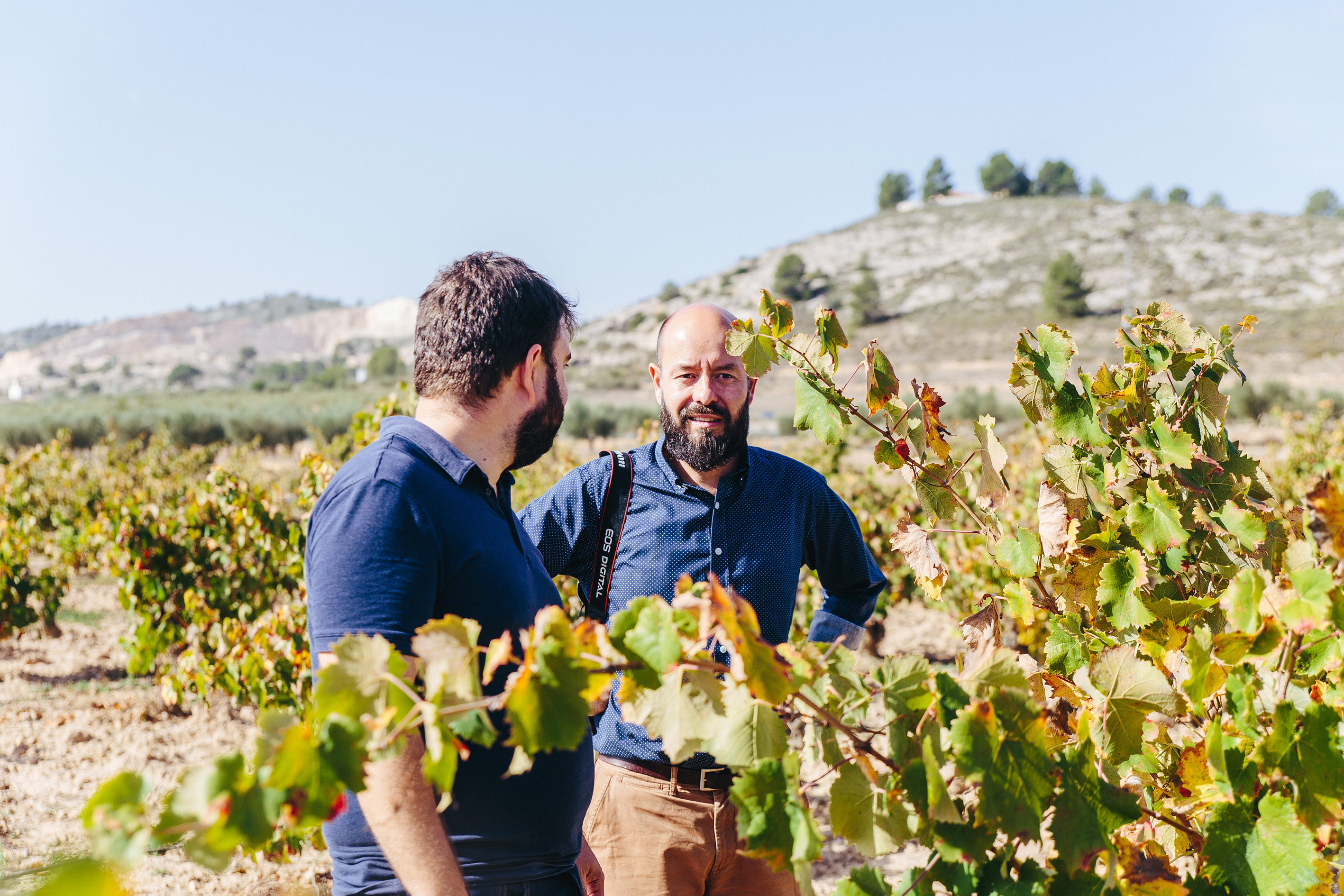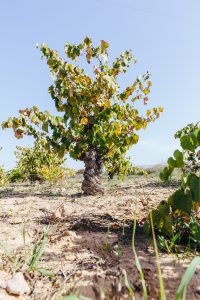
Background
David Carbonell founded Vins del Comtat in 1997. The Bodega is located in Concentaina, in Alicante’s El Comtat region, some 50km inland from Benidorm on the famous Costa Blanca. There is a huge contrast when travelling away from the high-rise tourist hotels and long swathes of beaches towards the mountainous terrain and inland villages.
Vins del Comtat have 15ha of their own vineyards. They also work with many small contract growers, managing lots of small vineyards parcela, spread across the mountainous, inland regions of Alto Vinolópo, El Comtat and L´Alcoiá and Marina Alta on the coast.
Vins del Comtat is committed to working with their small growers to restore and preserve the many small parcels of old Monastrell and Moscatel de Alejandría bush vines. David identifies very closely with Alicante’s wine heritage. He is involved in several wine projects which he sees as an important part of the cultural identity of the region. He instigated the partnership Colección de Toneles Centenarios for producing Luis XIV Fondillón, one of Alicante’s rarest and most unique wines.
In sharp contrast with Vins del Comtat, David has a strong interest in exploring and working with varieties which are not local or traditional to the region. In 2006 he experimented with planting different varieties: Viognier, Syrah and Cabernet Sauvignon. He advocates the benefits of the diversity of microclimates across individual vineyard parcels. These are carefully studied to match with and gain the best from each variety they are working with. They wanted to see which would adapt best to different soils and locations within the local conditions at higher altitudes, with high daytime temperatures, cool nights and low rainfall.
Region / History
There are lots of indications of a quiet revolution and revitalisation going on in one of Spain’s oldest, but until recently, less well known, wine producing regions.
Alicante’s heyday was in the 19th century, when there was a massive expansion in production to meet demand from France, whose vineyards had suffered the devastation from phylloxera, well before it reached Spain. Alicante’s strong trading position as a Mediterranean port capitalised on this ‘preferential trading agreement’. The area under vine expanded to around 93,000ha and production moved towards larger cooperatives. After phylloxera finally hit Alicante, many vineyards were left abandoned and today the area under vine is barely 10,000 ha. In the 20th century tourism and industry took over and the region became better known for its Costa Blanca Mediterranean coastline and resorts.
Since the 1990s Alicante has begun to rediscover its vinous roots. New winemakers began emerging and re-exploring the old varieties and abandoned vineyards. As ever Spain’s strong heritage of local grape varieties has come to the fore. These have now been combined with modern approaches to winemaking, with a focus on lower intervention and natural styles.
The wines now emerging from Alicante also tend to reflect this contrast between the inland and costal sub regions of the DO. To the north-east of Alicante toward Dénia, Marina Alta and Marina Baja producers are focusing on modern innovations of the traditional Moscatel de Alejandría. The inland regions to the north and west work with Spain’s stalwart, red variety, Monastrell (or Mourvèdre).
Monastrell accounts for about 75% of the grapes planted in the region. It is late ripening and well suited to the hot dry conditions inland, benefiting from the cooler nights and higher altitudes to maintain its naturally higher acidity. The remainder is white production with a small amount of rosé and sparkling produced and a tiny amount of Fondillón.
Geography / Climate
Alicante is bordered to the west by the winemaking regions of Yecla and Jumilla, with Murcia to the south. Collectively, they form the hot, dry region, south of Valencia, inland from the eastern coastline, often referred to as the ‘Levante’. This name characterises the very arid, mountainous nature of the region with long hot summers and low rainfall.
Alicante DO is divided in to 9 sub regions. These are split roughly between coastal areas with a Mediterranean climate and maritime influences and those further inland. Here, the climate becomes increasingly continental, as this mountainous interior approaches Spain’s central plateau. The very low rainfall and dry heat means a lower humidity, which helps maintain good vine health. Alicante has the highest proportion of organic production as a region, in Spain.
Cultivation and Vineyards
Vins del Comtat’s own 15ha vineyards include Monastrell, Giró and a parcel of 30-year-old Cabernet Sauvignon vines. They also work a further 40ha with contract growers. These include many old ‘en vaso’ (bush vine) parcels of Monastrell and Moscatel de Alejandría between 30 and over 100 years old, plus parcels of Cabernet Sauvignon, Merlot and Chardonnay. Their own, newer ‘experimental’ plantings include Merlot, Shiraz, Pinot Noir, Petit Verdot and Viognier.
The vineyards are spread across several locations in Alicante’s DO sub regions:
Coastal region: Marina Alta
c.100m above sea level
Benitatchell village – Moscatel de Alejandría
Inland (Montaña) regions: Alto Vinolópo, El Comtat and L´Alcoiá
550-650m above sea level
Planes village – Viogner
Canyada, Beniarres, Beneixama and Banyeres villages – Monastrell and other red varieties

The old bush vines typically have very low yields. David emphasises that these old vines need close monitoring to maintain their long-term health. Vins del Comtat aim to work to organic principles in most of their plots. The very dry climate helps maintain low levels of fungi and other diseases and reduces the need for using any treatments on the vines.
They also provide incentives for their contract growers, based on quality rather quantity criteria to help promote and support sustainable viticulture in the region. There is no irrigation except for any new young vines. Everything is picked by hand.
Winemaking
The winemaker is Joan Guia who splits his time between Vins del Comtat and Finca Collado in Salinas.
The winery at Cocentaina is well equipped, with what David refers to as ‘the latest technology in the wine world’. He considers this essential to gaining the most from the grapes by ensuring everything is maintained in the best condition from harvesting to the finished wines. Some of their stainless steel tanks have the Ganimede system, which incorporates an internal cone, to allow control of the CO2 generated. This is then re-used via controlled release to break up and submerge the cap during fermentation.
Despite the high-tech approach to equipment, the overall philosophy is based on low intervention principles. They work with the naturally occurring yeasts to retain the individual character and aromatics in the wines. They limit handling and movement to keep requirements for sulphur to minimal levels. The ripe grapes tend toward higher alcohol levels and higher natural acidity, which help to create stable, balanced wines.
They have a mix of French, American and Hungarian oak barrels in a range of sizes. In general, they now tend to use more of the 500 litre size. They are seeking to produce Monastrell styles with less oak influence, lower tannins and more fruit.
On average they produce a total of 170,000 bottles per year from the 55ha, which roughly equates to medium sized level of production for bodegas in Alicante.
The Wines
Santa Bárbara de Alicante 75% Monastrell 25% Cabernet Sauvignon
A blend of Monastrell from different plots at around 650m, typically on calcareous soils. The Cabernet Sauvignon vines, come from Vins del Comtat’s own vineyard and average over 30 years old. The wine spends 4 months in American and French oak 500L barrels and has a minimum of 6 months in bottle before release.
“Santa Barbara is a mature red, with persistent aromas of berries (blueberries, blackberries …) and good acidity that adds freshness. The palate is soft, with great fruit intensity, light toasted flavors (vanilla, coconut) and a long finish and warm. It is a wine with great balance and harmony. “
Monastrell ‘M’ 100% Monastrell
40 year old vines from different small vineyard parcela spread across the different Alicante montaña (mountainous) regions of Alto Vinolópo, El Comtat and L´Alcoiá. The wine is matured in a combination of roughly a third 300L and two thirds 500L new French and American oak for 6 months and given a minimum of 12 months ageing in bottle.
“These very dark violet wine have a high colour intensity, showing how they have absorbed the long hours of sunshine enjoyed in this region. This gives them a high phenolic content and a high percentage of Resveratrol, the best antioxidant for humans. The region’s dry conditions bordering on drought have made the wine strong and dense with a powerful aroma.”
Monastrell ‘El Salze’ 100% Monastrell
A blend from several different grower ‘parcela’ located in El Salze near Beneixama, close to the Sierra de Mariola Natural Park. These are bush vines from 40 to 60 years old at around 630 meters above sea level. The grapes undergo a gentle maceration in stainless steel before ageing in 500 litre new French oak barrels. There is minimal use of sulphur and a very light filtration.
“Cherry colour, very lively and lively, with a medium layer. Its aromas, very intense, are reminiscent of plums, white pepper and floral notes. The palate is fresh, deep and very balanced. Good balance between fruit and wood and great persistence. “
Montcabrer 90% Cabernet Sauvignon 10% Monastrell
These grapes come from small vineyard plots in the Comtat area. The Cabernet Sauvignon vines here are from a 30 year old parcel belonging to Vins del Comtat. The Monastrell grapes are from some 100 year old vines, which yield about 1kg per vine. Grown on steep, stony limestone slopes facing South-West at 550 meters above sea level. There is careful sorting and selection both in the vineyard and at the winery. Fermentation is in 500L new oak casks, with 14 months ageing in French (Allier) and American oak. A minimum of 12 months aging in bottle before release.
“Fairly intense Bigarreau cherry colour. It is a complex wine, potent but with elegant tanines a long, warm Mediterranean wine. Surprising ripe berry aromas, moist evergreen oak, aromatic herbs… In mouth it furnishes balsamic notes, dark-roast (coffee, chocolate), notes of cream and liquorice. Slightly mineral finish.
Monastrell ‘1921’ 90% Monastrell 10% Tortosí
This wine is from a single vineyard in Cañada which dates from 1921. It is 574 meters above sea level with sandy soils. The vines are mostly Monastrell, but it is effectively a field blend as the remaining 10% of the grapes are from Tortosí vines, which is a white, almost forgotten, local variety. All the grapes are picked and fermented together. The grapes underwent a gentle maceration and ageing in 500L French oak 1, 2 and 3 year old barrels for 12 months, with a year in bottle before release. The terroir helps produce fine tannins in the wine.
“Bright cherry colour, with middle layer. Good aromatic intensity, with clean aromas of plums, pomegranates and with a creamy toasting. In mouth, it has a soft entrance, with a great medium step and a very fresh finish. This great balance and the low load of the vineyard transmit in a great tasteful harmony.”
www.vinsdelcomtat.com
| Santa Bárbara de Alicante | pack shot | fiche |
| Monastrell ‘M’ | pack shot | fiche |
| Monastrell ‘El Salze’ | pack shot | fiche |
| Montcabrer | pack shot | fiche |
| Monastrell ‘1921’ | pack shot | fiche |